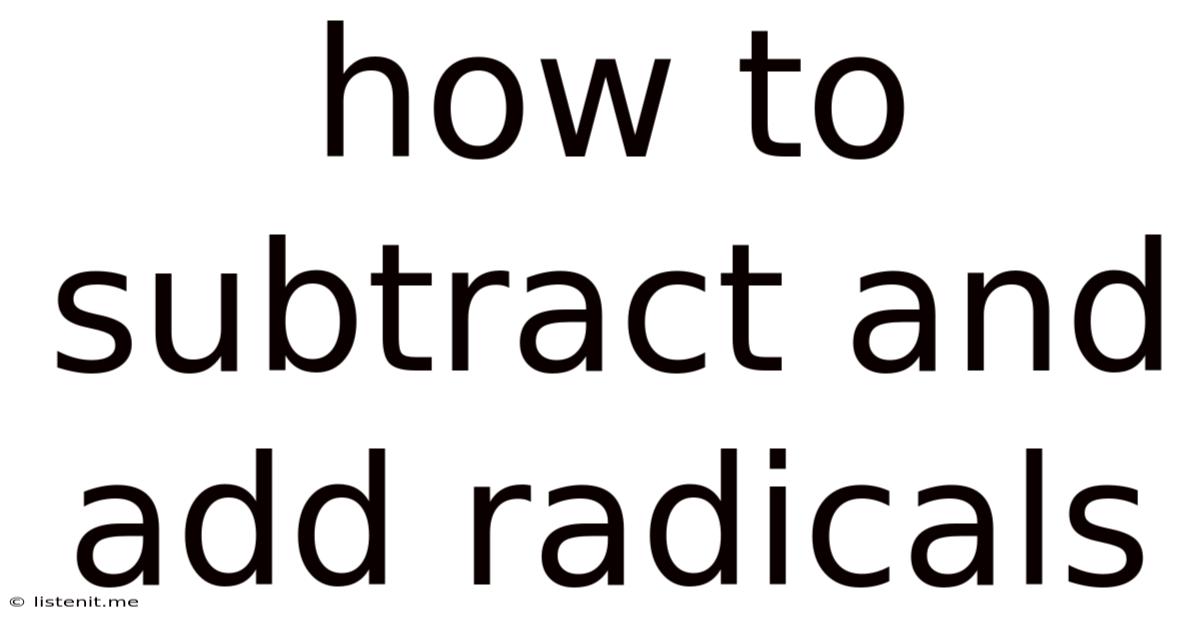How To Subtract And Add Radicals
listenit
May 11, 2025 · 4 min read

Table of Contents
How to Add and Subtract Radicals: A Comprehensive Guide
Adding and subtracting radicals might seem daunting at first, but with a clear understanding of the underlying principles, it becomes a straightforward process. This comprehensive guide will break down the steps, offer practical examples, and equip you with the confidence to tackle even the most complex radical expressions. We'll cover everything from simplifying radicals to handling different indices and coefficients. By the end, you'll be a radical arithmetic master!
Understanding Radicals
Before diving into addition and subtraction, let's refresh our understanding of radicals. A radical expression is an expression containing a radical symbol (√), which denotes a root. The number under the radical symbol is called the radicand, and the small number (or index) above the radical symbol indicates the root being taken (e.g., √ is the square root, ³√ is the cube root, etc.). If no index is written, it is implicitly a square root (index of 2).
Simplifying Radicals
Simplifying radicals is crucial before adding or subtracting them. The key is to find perfect square (or cube, fourth, etc., depending on the index) factors within the radicand. Let's illustrate with examples:
Example 1 (Square Roots):
Simplify √72
We look for perfect square factors of 72. We know that 72 = 36 * 2, and 36 is a perfect square (6*6). Therefore:
√72 = √(36 * 2) = √36 * √2 = 6√2
Example 2 (Cube Roots):
Simplify ³√54
We look for perfect cube factors of 54. We know that 54 = 27 * 2, and 27 is a perfect cube (333). Therefore:
³√54 = ³√(27 * 2) = ³√27 * ³√2 = 3³√2
Example 3 (Higher Roots):
Simplify ⁴√80
We look for perfect fourth power factors of 80. We find that 80 = 16 * 5, and 16 is a perfect fourth power (222*2). Therefore:
⁴√80 = ⁴√(16 * 5) = ⁴√16 * ⁴√5 = 2⁴√5
Adding and Subtracting Radicals
The fundamental rule for adding and subtracting radicals is that you can only combine terms that have the same radicand and the same index. Think of radicals like variables: you can only add or subtract like terms.
Example 4 (Simple Addition):
2√5 + 3√5 = (2 + 3)√5 = 5√5
Example 5 (Simple Subtraction):
7√2 - 4√2 = (7 - 4)√2 = 3√2
Example 6 (Adding with Simplification):
√12 + √27
First, simplify each radical:
√12 = √(4 * 3) = 2√3 √27 = √(9 * 3) = 3√3
Now, add the simplified radicals:
2√3 + 3√3 = (2 + 3)√3 = 5√3
Example 7 (Subtracting with Simplification):
√50 - √8
First, simplify each radical:
√50 = √(25 * 2) = 5√2 √8 = √(4 * 2) = 2√2
Now, subtract the simplified radicals:
5√2 - 2√2 = (5 - 2)√2 = 3√2
Example 8 (More Complex Expression):
3√18 - 2√8 + √50
First, simplify each radical:
√18 = √(9 * 2) = 3√2 √8 = √(4 * 2) = 2√2 √50 = √(25 * 2) = 5√2
Now, combine the simplified radicals:
3(3√2) - 2(2√2) + 5√2 = 9√2 - 4√2 + 5√2 = (9 - 4 + 5)√2 = 10√2
Dealing with Coefficients and Different Indices
When dealing with coefficients, remember to multiply them before combining like terms. For different indices, you cannot directly add or subtract unless you can simplify them to have the same index.
Example 9 (Coefficients):
4(2√3) + 5(√3) = 8√3 + 5√3 = 13√3
Example 10 (Different Indices – Requires Simplification):
√9 + ³√27
First simplify: √9 = 3 and ³√27 = 3
The expression becomes: 3 + 3 = 6
Example 11 (Different Indices – Cannot be Simplified):
√2 + ³√2
These cannot be simplified further and cannot be combined because they have different indices. The expression remains as √2 + ³√2.
Advanced Examples and Problem-Solving Strategies
Let's tackle some more challenging examples to solidify your understanding:
Example 12:
Simplify and add: 2√(1/4) + 3√(4/9)
First, simplify the fractions within the radicals:
√(1/4) = 1/2 √(4/9) = 2/3
Then substitute: 2(1/2) + 3(2/3) = 1 + 2 = 3
Example 13:
Simplify and subtract: 5⁴√(16x⁴) - 3⁴√(81x⁴) (assuming x is non-negative)
First, simplify the radicals:
⁴√(16x⁴) = 2x ⁴√(81x⁴) = 3x
Then substitute: 5(2x) - 3(3x) = 10x - 9x = x
Conclusion
Mastering the addition and subtraction of radicals involves a systematic approach. Remember to simplify each radical expression first by identifying and extracting perfect nth powers. Then, only combine terms that possess identical radicands and indices. With practice, you'll develop fluency and accuracy in handling these expressions, transforming seemingly complex problems into manageable and solvable ones. Consistent practice with a variety of examples is key to becoming proficient in this essential algebraic skill. Remember to always check your work and simplify your answer as much as possible.
Latest Posts
Latest Posts
-
The Si Unit Of Volume Is
May 11, 2025
-
Solve For X The Triangles Are Similar
May 11, 2025
-
How Can We Tell If Conductivity Is A Physical Property
May 11, 2025
-
How Much Is 2 3 And 2 3
May 11, 2025
-
Lead 2 Nitrate And Sodium Carbonate
May 11, 2025
Related Post
Thank you for visiting our website which covers about How To Subtract And Add Radicals . We hope the information provided has been useful to you. Feel free to contact us if you have any questions or need further assistance. See you next time and don't miss to bookmark.